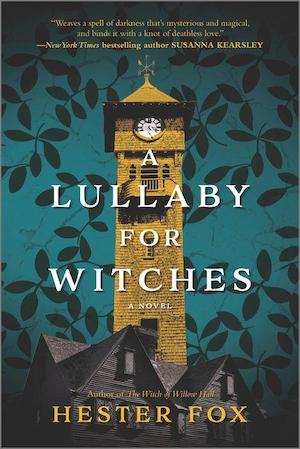A Lullaby for Witches takes place in two time periods and from two points of view. The first major character is Augusta Podos, a young woman who lives in contemporary times who gets a job at the historically preserved Harlowe House. Augusta is in a not-so-great-place at the beginning of the book; she’s in a dead-end relationship and has little confidence in herself, in no small part because of her current boyfriend.
The other major character is Margaret Harlowe, a strong-willed woman from the 1870s who has some “witchy” tendencies and who ends up loving the wrong man and paying for it, as women of that time often did. We don’t know the details of her story at first, as she’s been lost to history. Her spirit, however, still haunts the Harlowe House, which in Augusta’s contemporary Massachusetts is now a historically preserved building that puts together exhibits of Massachusetts from years yore.
The story moves messily on from there, with us jumping from Margaret’s time to Augusta’s struggles in the present day without really spending time with either of them. It’s clear that we’re supposed to see Augusta becoming self-empowered and independent as the book moves on, but the text isn’t there to make this journey for her believable. After leaving her old boyfriend, for example, she immediately starts dating someone new in insta-love fashion. And while Augusta does ask herself if she’s jumping into something too soon, she simply decides she’s not, a conclusion we’re clearly supposed to agree with even though there’s nothing in the book that supports her claim.
Buy the Book


A Lullaby for Witches
Augusta also has an eating disorder that is referenced several times through the book but never addressed by her or other characters except through the sad looks she gets from time to time when she says no to a piece of chocolate cake or a croissant from the coffee shop. Perhaps the author added Augusta’s eating disorder to give dimension to the character. At best, however, it feels like a tacked-on attribute, and at worse it minimizes disordered eating in that it’s never directly addressed as something she wants to change, even when she becomes “empowered.”
Margaret in 1876 has her own complexity—she’s a well-to-do woman but also a free spirit who provides medicinal herbs to the women in town when they need it. She also has some real magic abilities, though this is barely touched upon in the story (for a story with “witches” in the title, there’s very little to do with witches in the story), and also falls for the wrong man. As the book progresses, the women’s two stories become more intertwined until there’s a twist so hard at the end that propels the story into a very surprising, some would say unearned, conclusion. (There are also several major plot holes in the tale that may or may not bother you, depending on how much you care about logical consistency in a story.)
All this is not to say that there aren’t some well-crafted moments in the book. Fox describes the setting of Harlowe House well, and those who love the vibe around historical buildings will enjoy spending time with Augusta there as she tries to unearth Margaret’s story. The handful of scenes where Augusta has visions of Margaret’s life are also vividly described and are the strongest parts of the book.
Those moments, however, aren’t enough to make up for the underdeveloped characters (or arguably overdeveloped—Augusta has a lot going on in her life, but all these facets of what she faces are thrown at us and none fully delved into to give Augusta any depth or make a strong case for how she is supposed to have changed over the course of the book).
If you’re looking for something light and quick to read and like places like Harlowe House, it might be worth your time. There are lots of gothic, witchy, historical fiction books out there though, and this one is not at the top of the list.
A Lullaby for Witches is published by Graydon House.
Vanessa Armstrong is a writer with bylines at The LA Times, SYFY WIRE, StarTrek.com and other publications. She lives in Los Angeles with her dog Penny and her husband Jon, and she loves books more than most things. You can find more of her work on her website or follow her on Twitter @vfarmstrong.










